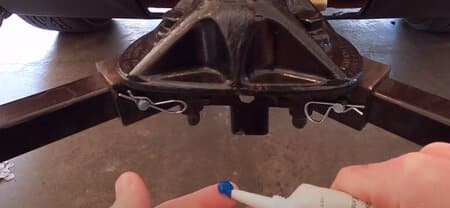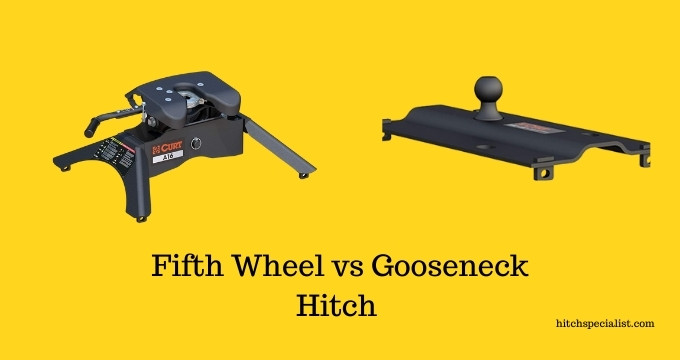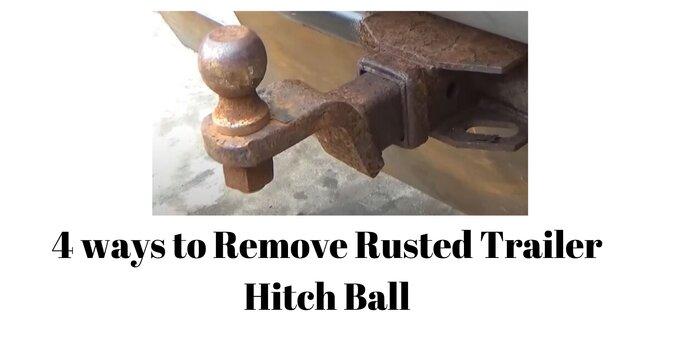
The purpose of a weight distribution hitch and a sway bar is the same, providing you with a safe, smooth ride and a controlling way. You may wonder why there are so many varieties if it’s that simple. Because each has a different system and functionality to get its job done.
Also, every trailer/truck/RV combination and their gross trailer weight are unique. When we were rookie hitch enthusiasts, we made mistakes by installing the wrong type of hitch and bar for our RVs, which was a waste. Even the best hitch or sway bar might not suit your truck if not installed according to truck measurements.
Back to where we were, a weight distribution hitch transfers weight to the front wheels of your carrying vehicle, the trailer, and the major portion is carried by the weight distributing hitch itself. On the other hand, a sway bar creates resistance when any sway occurs and evenly distributes it to the vehicle’s wheel suspension action components.
How does it happen?
We’ve broken down both the sway bar and weight distribution hitch below.
Weight distribution hitch vs sway bar: Comparison Chart
Here’s the key comparison table of Sway Bar and Weight Distribution Hitch:
Concern | Sway Bar | Weight Distribution Hitch |
Function | Torsion bar creates resistance in contact of any wind gusts | Redistributes tow vehicle & gross trailer weight through the front, back & trailer axles |
Towing Capacity | Can not tow weight | 600 lbs top 24,000lbs |
Attachment | Attached to the vehicle suspension component | Attached to the bumper pull ball hitch |
Versatility | Doesn’t include weight distribution | Recent models include sway control |
Noise | Noisey | Creates noise to an extent |
Usage | Great for dangerous roads | Great for road shocks and a long ride |
Price |
Also read: Blue ox sway pro weight distribution hitch vs Equal-I-zer
Let’s now talk about the differences briefly.
Weight Distribution Hitch

What is a Weight Distribution Hitch?
Before we begin, you need to understand the term gross trailer weight. It means the subtotal including any item or cargo included, rear axle weight of a trailer. Tongue weight is about 24% of gross trailer weight and the percentage changes from vehicle to vehicle.
Whenever you hook another trailer to your truck, the newly attached trailer and the weight inside the trailer put extra pressure(tongue weight) on the tow truck. The excess tongue weight causes an uneven balance between the two vehicles.
So, wind, a U-turn, brakes can make the tow truck lose total balance and road bumps.
Most of the time it causes accidents. A weight distributing hitch is a tool that spreads the tongue weight of an attached travel trailer or RV or any vehicle evenly to prevent any disturbance. More specifically, it distributes the gross trailer weight to the front and back wheels of the towing vehicle. The core purpose is to even out the load for a safe ride. Some call it tow hitch; some call it, load-equalising travel hitch.
Also read: How to Choose the Right Weight Distribution Hitch?
How does Weight Distribution Hitch work?

During the squatting phase (the front axle of towing vehicle becomes uneven to excessive trailer tongue weight), the tongue weight transfers entirely on the back axle causing the front axle to be weightless. Again, the results are uneven.
A weight distribution system most commonly sits on the joint at the towing hook attached to spring arms and pushes a 40-40 to the front, back axle, and 20% to trailer axles. For example, a 1000lb tongue weight trailer needs 2500lbs weights to be evenly distributed. While using a weight distributing hitch, it will distribute 1750 lbs to the back axle and rest to the trailer axle or 1000 lbs on both front or back wheels of the towing vehicle.
The rest of 500lbs will go on to the trailer axle. In the whole process, the spring bars are attached to the trailer frame and receiver through the trailer ball couple. This way, it prevents the weight from falling on only one side and contains squatting or uneven lines.
Still, there’s a big BUT. If the hitch is not compatible with the measurement of the tow, spring arms & bars, and tongue weight needs of the towing vehicle & trailer, there still will be squatting.
Key features of Weight Distribution Hitch
Safe ride
The prime feature of Weight Distribution Hitches is to provide a safe ride preventing accidents. Most heavy-weighted trailer RVs require even weight distribution systems because of the long and bumpy roads and not to forget high wind & unknown forces. Weight distribution hitches immediately transfer the weight ratio whenever it comes into contact with road shock and any barrier, ensuring a sway-free safe journey.
Round/trunnion bar
Round bars mean spring bars that look round in shape. Weight distributing hitches differ in bars because some vehicle models don’t align with regular spring bars. However, round bars have less ground clearance than trunnion style bars. Trunnion style bars are square and come in the position of a hitch head. They don’t differ in performance, just in shape.
Sway control
Chain attached hitches need manual attachment while changing direction. Besides, it’s more affordable than steel bar hitches. Steel bar hitches include integrated sway control directly connected to the tongue through an L pin. It provides four points of sway control, and the chain offers two.
Towing capacity
Towing capacity means the number of pounds or lbs the hitch can distribute. The capacity of a Weight Distribution Hitch depends on the model you are buying and the tongue weight of your tow vehicle & tow package. Manufacturers provide 600lbs to 24,000lbs towing capacity weight distributing hitches currently on the market.
Things we like about the Weight Distribution Hitch
- It provides even weight transfer that a standard hitch can not
- It prevents the front axle from lifting upward amidst riding
- Weight Distribution Hitch Stops side to side motion sway from heavy wind, road bumps
- Adjust weight immediately during break or motion
- Weight Distribution Hitch provides control over both tow truck & trailer
- Most Weight Distribution hitches provide a quiet journey
- According to our test, it reduces up to 86% of tire pressure on the truck/trailer components.
- Ensures a safe and smooth towing experience
The negative side of Weight Distribution Hitch
- Setting up a regular Weight Distribution hitch can be difficult, especially for beginners.
- Every time changing path a chain wd hitch needs resetting
- Inaccurate measurement and tongue capacity can cause damage
Do I really need a weight distribution hitch?
If you are towing half or more than half the capacity of your vehicle weight, you should get one. Simply compare vehicle and trailer weight.
For example, our Ford F150 requires a weight distribution hitch to tow Airstream RV.
Because its gross weight is 5,000lbs and Airstream towing needs 2500lbs+ capacity. Also, if you use a weight distribution system, then there are significantly fewer chances of accidents.
Some of our favorite Weight Distribution Hitches
1) Andersen Hitches No-Sway Weight Distribution Hitch

Andersen no sway has to be the market leader in chain weight distributing hitches. There are no pry bars required while setting this up. From our test, Anderson provided a very smooth ride and it’s very lightweight. It sets up the spring bars instead of adjusting them and doesn’t create much of a noise. Moreover, it is heavy duty and has excellent sway resistance.
2) Equal-i-zer 4-point Sway Control Weight Distribution Hitch

Equal-i-zer hitch has 4 points resistant sway control that controls weight transfer and faces any sway and provides a smooth steering experience. What we love most about this hitch is that it fits all kinds of bumper pulls.
Not sure which one to choose? Read Andersen Weight Distribution Hitch vs Equal-i-zer comparisons.
Looking for different weight distribution hitch brands or models? check here:
- Eaz lift Recurve r6 weight distribution hitch review
- Eaz Lift Recurve r3 hitch Reviews
- Best 3 Blue ox sway pro weight distributing hitches
- Fastway e2 Hitch
- Reese Strait-line weight distribution hitch
Sway Bar and Sway Control
Now let’s talk about Sway Bar and Sway Control
What Is Sway Control?

Standard ball hitches have a ball mount inside that lets an attached tow vehicle move while driving. Regular bumper pull trailers can not control how much the trailer or RV moves. It can move up to a 90-degree angle, which ultimately causes slip.
This is called sway. Sway control means minimizing the probability of adverse towing and providing strong trailer stability while driving. Sway bars and Weight Distribution Hitches with sway control are popular tools for sway control.
How do Sway Control and Bar work?
Most of the time, trailers sway at most four and a half inches behind the towing truck. Sway control bars utilize the RVs or carried vehicles’ gross weight to create balance and avoid sway. It reduces sway by putting the trailer axle against the weight of the chassis.
Note: even though the distribution is done equally to balance, we recommend checking the cargo weight distribution.
Putting some items in a balanced way always helps. Also, the sway bars hold the truck whenever it detects any kind of force. Then it aligns your vehicle’s travel trailer as before and effectively prevents sway.
Why do you need a Sway Bar?
First, let’s see what a sway bar is. The sway bar includes wheels, steering, bushing, join, and basically, it is part of your vehicle’s suspension. These are similar to friction bars, but they don’t stop only reacting to bar twists but also stabilizing them.
Sway bar control systems act quickly to align your vehicle from turbulence. That also reduces sway. Also, it attaches near the body of the tow truck from the left to the right wheel. If your truck needs forceful brakes and turns in the journey, you must include an anti-sway bar. The variety and number depend on the measurement and the highway line.
So, whenever you experience sway, the sway bar stops the excessive side force and the twisting motion. Moreover, one of the important reasons is to prevent the truck & trailer from moving too many specialists in a zigzag manner amidst traveling.
Is a weight distribution hitch the same as a sway bar?
In short, no. Weight distribution hitch transfers weight to prevent falls out of the trailer. It provides sway control to some extent. On the contrary, a sway bar prevents sway using a spring mechanism. It doesn’t distribute weight. There are a lot of weight distribution hitches with sway control systems. Also, there are models of sway control hitches. However, sway bars don’t provide weight transfer and balance.
Key features of Sway Control and Bar
Prevents trailer slip
A sway bar provides more control to a trailer which simply means it prevents a trailer from moving in a swinging motion while driving. It uses friction to balance out both the tow vehicle and trailer.
Better traction
Through the sway bar, you can gain steering control and take brakes. Even at a 360-degree angle sway bars work best to prevent any kind of falling out. For example, if you’re going on an icy highway, sway bars are your best friend or if you’re running on a muddy road sway bars provide enough support to prevent any slip.
Attached/non attached
Sway bars come in integrated sway control or built-in sway control and other manuals
Things we like about Sway Bar
- Provides fantastic resistance against any kind of external force while driving
- Great for taking 360-degree turns
- Accompanies while taking any sudden break
- From our test, the sway bar provides 98% sway control in real time
- Affordable
- Easy installation
- Reduces traction and helps the vehicle to move even its not towing
- Compatible with wd hitch
- Great for single axle and a short journey
Cons of Sway Bar
- It doesn’t have a weight distribution system.
- A bit noisy
Our favorite Sway Control Bars
1) EAZ LIFT 0224.2014 Screw-On Sway Control

Our go-to sway control bar hands down is Eaz-Lift’s sway control bar. It only takes an attachment to a bumper pull with spring connectors and the installation is good to go. However, it has an automatic sway control detector that provides auto sway when it encounters torsion twisting resistance.
2) CURT Trailer Anti-Sway Bar Control

Curt sway bar is a heavier version than the Eaz life one. It uses a brake pad to stop the sway. However, you only need to install it once because it has integrated sway control. Also, one of the good points about this sway bar is it universally fits every type of weight distributing hitch.
Weight distribution hitch and sway control FAQs
How tight should weight distribution bars be?
It depends on your vehicle measurements, to be specific. However, the bars should be tight to provide hitch ball adjustment and not overload the ball hitch. For example, a 4 inches shank needs half and half tightening of the wd bars because the more angle, the more the wd hitch turns to the ground.
Can you back up with a weight distribution hitch?
Most chain models do by default but hitches like Equal-i-zer allow backup or reversing. From our experience, hitches with sway control should avoid the backup. If your hitch has only weight distribution you can do reversing. Always read the owner’s manual and check the manufacturer’s website.
When should you not use a weight distribution hitch?
You should not use a weight distribution hitch when the gross vehicle weight rating exceeds the hitch towing capacity. Also, if you find it difficult to steer or do not know how to install a weight distribution hitch.
Should I grease my weight distribution bars?

If you hear harsh noises while driving, that’s an indicator that the bars need oiling. We often lubricate grease to our bars to reduce noise and for a smooth ride.
Are sway bars loud?
Traditional friction style sway bars are loud. But you can always reduce them by reducing the tension on the control bars. However, it will provide less control to sway. Brands like Eaz lifts, and Curt provide friction style yet noiseless sway bars.
Should sway bars make noise when turning?
If your sway bars make noise whenever you turn, chances are the suspension joints are broken. It can be the power steer pump that might cause the sound. Most commonly, ball joint failure leads to noise while turning.
Weight distribution hitch or Sway bar: Which one to choose?
If you’ve read it till now, you should be clear about the difference between these two. One distributes weight for balancing, and one resists any kind of turbulence. But the best combination is the two together.
We recommend using a weight distributing hitch with sway control or compatible with a third-party sway bar. Without weight distribution and sway control, the risk to your vehicle is 5 times more than while using these. If you run through harsh environments, icy, windy, or woody roads, get both or a hybrid of both like the Andersen or Equaliser. On the contrary, if you have less than 1200 lbs of cargo or 1000 lbs below gross tongue weight, then a sway bar like Curt should be fine.




